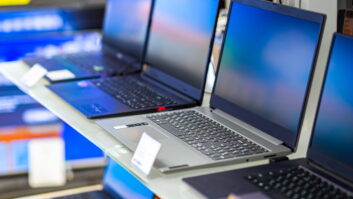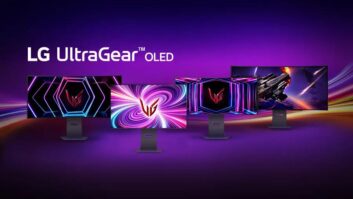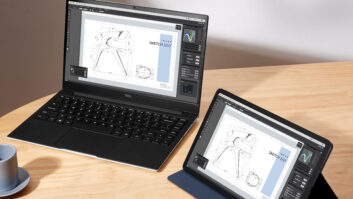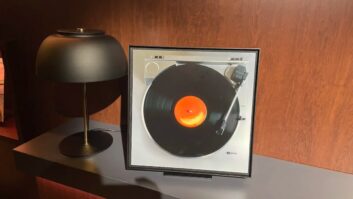LAS VEGAS –
When Android-based tablet PC
vendors describe their experience in the category
to date, the two most commonly heard adjectives
are tough and challenging.
No little part of this stomach-churning angst is
generated by the company based in Cupertino, Calif.,
that has dominated the category like King Kong
did to New York City from the top of the Empire
State Building.
Apple’s presence – combined with a flood of tablets
into, and many out of, the category – created
a swarm of products vendors had to contend with
just to get their markets on store shelves for most
of 2011. The tide rose even further when Amazon
and Barnes & Noble fully entered the fray with lowpriced
tablets in the late fall, just in time for the holiday
selling season.
“Tablets have been a roller-coaster ride with
peaks and valley. It has been more of a challenge
than anticipated – there is lots of competition,” said
Eric Ackerson, Acer’s senior product marketing
brand manager.
ViewSonic’s Michael Holstein, business development
VP, agreed. He said the higher end of the
market is a tough place to play right now, and that
ViewSonic has had much more success with its value-
product line, which is priced in the $299 range.
And this situation will not only remain in 2012, but will probably grow more intense as additional players
enter the field.
The trick for all the vendors this year will be proper
product positioning and doing their best to gain mindshare
from Apple and Amazon.
While the non-Apple players have not totally thrown in
the towel when it comes to competing with the iPad, all
recognized the fact that consumers with enough money
to buy an iPad will do so over that of another device.
“If they have $599 or $699, they are going to buy an
iPad,” said one manufacturer who requested anonymity.
On the flip side, companies have welcomed the introduction
of the $199 Kindle Fire and $249 Nook Tablet.
The general thought is these lower-priced, high-profile
products will expose millions of people to tablets who
might otherwise bypass the category due to the high
entry-price.
Pandigital falls into this camp.
Jason Topel, marketing and product development VP
for Pandigital, said that while the Fire does bring additional
competition to the market, it is also a great eyeopener
for the general public.
“We were always compared to the iPad, but with the
Fire and other entries, people are realizing its Apple, and
another world — Android,” Topel said.
This thought was proven true. In early December Amazon
released its top-selling holiday products to date
and the Pandigital 7-inch tablet was No. 2 for the computer
category. Amazon’s figures did not include sales
of its own products, however.
Acer’s Ackerson agreed, stating that the Fire has invigorated
the category with the lower price, making the
tablet more accessible to the average consumer.
Companies like Acer and others are viewing these
Fire and Nook Tablet as gateway sales that could lead,
down the road, to consumers eventually wanting either
a second or larger device.
“Acer offers a different experience. The buyer is not
locked into an operating system with our device and still
has access to the Kindle store and e-reading app,” Ackerson
said.
With tablets, both of the Apple and non-Apple persuasion,
now firmly in consumer’s minds, the market is
getting ready for 2012 to be different from last year.
The number of one-off models from relatively unknown
companies will be more limited, unlike last year
when 30-plus tablets were on display at International
CES, said Topel. This will greatly benefit everyone, he
said, as these tended to not only disappoint consumers,
but retailers, as well.
Another area that proved to make the tablet category
challenging for its charter members was Google.
While Google’s Android operating system powers
the majority of the non-Apple tablets, the search engine’s
development strategy has left many vendors hot
under the collar.
“While different Android versions helped in allowing
many types and services, the way they work by limiting
the initial release to a few partners and always releasing
it around Christmas makes it hard,” Holstein said.
“While Texas Instruments OMAP will have it all, the
others will have to wait, and this forces customers to
wait before making a purchase,” he added.
Google’s Ice Cream Sandwich version of Android
has been given to developers and is expected to be fully
released during the first quarter of 2012. Initially vendors
believed their models using Honeycomb and even
older Android 2.3 operating system could be automatically
updated to Ice Cream Sandwich, but now some
are backing off that claim, stating the end user may have
to directly connect their tablet to a PC for the upgrade
to take effect.
However, the manufacturers are looking forward to
the new OS as it will help unify the various tablet and
smartphone products.
Although even further down the road, ViewSonic is
starting to get excited over the release of Microsoft’s
Windows 8 operating system. Windows 8 is Microsoft’s
first attempt at delivering an OS created from scratch to
work with touchscreens.
This is of particularly interest to ViewSonic, Holstein
said, as his company is already producing tablets for vertical
and enterprise markets that have are dual bootable
to Android and Windows.
How much pressure Windows 8 can potentially place
on Android is unknown at this time. The main drawback
to Windows 8 is the Android markets huge assortment
of apps. However, Holstein said an Android App Player
is being developed by several companies, such as
Bluestacks, that will effectively allow Android apps to
be played in a Windows environment. In much the same
way there is an Adobe Flash app.
If Windows does find additional traction in the consumer
tablet space, it will open up the door for Intel to
start making inroads against all the Arm architecture
processors by Nvidia and Texas Instruments.
Holsein said Intel is working on altering the power
management technology on its chips to closely mirror
Arm. If this is accomplished, it would make Intel more
competitive as one of Arm’s great advantages over Intel
is its battery life, Holstein said.
Other improvements expected on tablets coming out
in 2012 are improved panel resolution, better design
and materials, and the ability to better directly connect
with other Wi-Fi enabled devices.
The first of these upgrades is already projected to
take place in 2012.
The tablet PC category will gain higher-resolution displays
in 2012, according to NPD DisplaySearch.
DisplaySearch is predicting tablet display resolution
will increase by 78 pixels per inch (ppi), going from 134
ppi in November 2011 to 212 ppi the following year.
The ability to pass content between devices will also
become important as more tablets appear in homes and
families gain the need to quickly and easily move video
and photos about.
Pricing is not expected to decline greatly, although
more vendors will target the $199 price point.
“$199 is the magical price and we are working hard to
get there,” said Ackerson.
Otherwise, from a cost perspective, nobody is seeing
a great deal of downward shift, particularly for the largerscreen
models.













